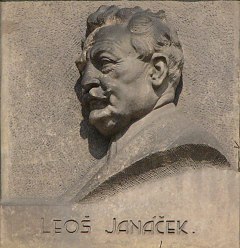The Cunning Little Vixen
| The Cunning Little Vixen | |
|---|---|
| Opera by Leoš Janáček | |

Relief of the composer by Julius Pelikán
|
|
| Native title | Czech: Příhody lišky Bystroušky |
| Other title | Adventures of Vixen Sharp-Ears |
| Librettist | Janáček |
| Language | Czech |
| Based on | serialized novella by Rudolf Těsnohlídek and Stanislav Lolek |
| Premiere | 6 November 1924 National Theatre, Brno |
The Cunning Little Vixen (Czech: Příhody lišky Bystroušky, lit. Adventures of the vixen known as Sharp-Ears, and, until the 1970s, generally referred to in English as Adventures of Vixen Sharp-Ears) is an opera by Leoš Janáček, composed 1921-23. Its libretto was adapted by the composer from a serialized novella (daily comic) by Rudolf Těsnohlídek and Stanislav Lolek, which was first published in the newspaper Lidové noviny. The opera incorporates Moravian folk music and rhythms. Described as a comic opera, it has nonetheless been noted to contain a serious theme. Interpretations of the work remain varied, ranging from children's entertainment to a tragedy.
Příhody = Tales (or Adventures)
lišky = of Vixen (i.e. genitive case, one fox, female)
Bystroušky = Sharp-Ears (double meaning: pointed [ears], clever, sly)
There is no mention in the Czech of a diminutive ("little"), although this idea is included in both the German (Das schlaue Füchslein) and recent (since 1980s) English versions of the opera's name. It was probably the German name, used for the 1965 Felsenstein movie, that established the English "cunning little," ignoring the important double meaning in "Sharp-Ears." The first three audio recordings, all from the Czech company Supraphon (Neumann 1957, Gregor 1972, Neumann 1980) used, naturally, the original Czech name. Then Decca recorded the opera with the Vienna Philharmonic in 1981, and this widely circulated release made The Cunning Little Vixen the international, if inaccurate, standard.
When Janáček discovered Těsnohlídek's comic-strip-inspired story and decided to turn it into an opera, he began work by meeting with the author and beginning a study of animals. With this understanding of the characters involved, his own 70 years of life experience, and an undying, unrequited love for the much younger, married Kamila Stösslová, he began work on the opera. He transformed the originally comedic cartoon into a philosophical reflection on the cycle of life and death by including the death of the vixen. As with other operas by older composers, this late opera shows a deep understanding of life leading to a return to simplicity.
...
Wikipedia
